Salvelinus namaycush. Tyrant of the lakes.
At the time, it was my nemesis. My fly fishing Ark of the Covenant. My angling El Dorado. As I stood on the banks of the Otherside River lining up the photo of the big fish, I felt a noticeable weight lift off my shoulders. The rain, for just a few minutes, stopped. A beam of sunshine poked through the low ceiling of clouds and I felt as though I'd just accomplished something nobody else on earth had ever done.
Truth be told, I probably did. But that's for later in this tale.
I'd tried for five days to catch a lake trout on a fly. I'd been denied each time.
The second day of our trip at Blackmur's Athabasca Lodge in the far northwest corner of Saskatchewan, we were informed of one of Lake Athabasca's oddities — an early spawning run of lake trout that actually swim like salmon or steelhead into the rivers that enter the enormous lake. They get so thick, we were told, that during the peak of the run they're an "every cast" proposition at the mouth of the Otherside River situated conveniently within eyesight of the lodge.
The peak of the run?
"Any minute now," said Cliff Blackmur, the namesake of the lodge that put up with us for a week. "They're late, so we're expecting them while you're here."
But, even a decade ago, Cliff could tell things were changing. Weather patterns are different in the north country these days. This time of year, he said, things should be dry and sunny during the day, and temperatures should be tickling the 32-degree mark overnight. Instead, on the second day at Blackmur's the wind whipped up out of the west, blowing in a front that brought with it four straight days of unsettled weather that included frequent rain (heavy at times), powerful gusts of wind and breakers on the lake that rivaled any I've experienced at sea. Nighttime temps dipped only into the 40s thanks to constant cloud cover.
It's the cold, Cliff explained, that brings this unique run of lakers — small by Mackinaw standards, weighing in between four and 12 pounds — into the river mouth and eventually up into the rapids and runs of the river to spawn. Without the cold, there’s no telling when the fish will show up.
But things were looking up. That very morning, our guide, Louie Isadore, motored us into the mouth of the river, and my fishing partner, Kirk Deeter, proceeded to stick a nice 10-pound laker on a purple bunny leach. It was a sign of good things to come.
But over the next several days, reports of lakers entering the river were spotty at best. We’d try each morning before heading out to face the wind and the rain on the big lake, and more often than not, we’d come up empty.
Louie had the most logical explanation.
“The fish are not here," said the native Canadian and a member of the Black Lake First Nation. "Let’s try somewhere else.” And off we'd go, to chase northern pike with fly rods, a thrill to be sure. But the trout ... their absence at the end of my fly line haunted me for days.
Then, as reports of lakers in the river mouth became more prominent ("We got four in 20 minutes!" ... that sort of thing) from fellow guests at the lodge, my inability to hook into one of the big fish was beginning to get under my skin. Finally, I came to grips with the likely reality — it wasn't meant to be. The lakers wouldn't be had, at least not by me, and not on this trip.
So, I took an afternoon toward the end of our week in the north country, hijacked Louie, and marched him up the Otherside River a mile or two to catch the lowly whitefish. The Athabasca whitefish is actually considered a worthy catch here in Saskatchewan. Louie, over the course of the week, raved about the whitefish's fighting ability, and I’m certain the fish has found its way to the table of many a First Nation family over the years.
I figured, since the lakers weren’t cooperating, I could at least add the whitefish to my trip’s small list of conquests.
We arrived at the river, and Louie pointed to the water, where sizable fish were actually rising, presumably to some unseen insect. I figured the catching would be rather simple — where I come from, whitefish don’t require too much thought to connect with, and they have saved many a trout trip from utter disaster. “Whities” will often take a fly when a rainbow or brown will remain stubbornly tight-lipped.
So when I tied a size 12 Adams to the tippet of my four-weight rod, I expected to make a couple of casts and latch into a whitefish. It wasn’t to be. In fact, as I stood hip-deep in the cold waters of this Athabascan river an hour later, trimming back a size 18 micro-caddis to little more than a bare hook so that it might, just possibly, resemble the emerger that these fish were obviously eating, I wondered to myself, “Could whitefish possibly be this selective? And could they possibly be this selective … here? In the middle of nowhere?”
"You sure these are whitefish?" I asked Louie.
"Yuh," he said shortly in the trademark First Nation accent, mixed slightly with the Canadian emphasis. "Whitefish."
Needless to say, I was more than a bit frustrated. And poor Louie was likely beside himself, wondering when the crazy American fly fisherman would call it a day and admit that the Otherside River’s whitefish had gotten the best of him.
"You have something that sinks?" Louie asked me. "Or do you have a Mepps Number One? Whitefish like that."
I brought precious little with me to this remote place, figuring I could tie flies as we needed them (and we'd needed them), and I didn't bring any spinning gear with me at all. But I did pick up a couple of weighted white Woolly Buggers from the lodge, thinking they might do the trick for the lake trout in the river mouth.
And then I had a thought. I asked Louie to hand me my Tenkara rod, a completely foreign tool to him and just about anyone else at the lodge who giggled at the thought of me and Deeter using these long, supple Japanese fly rods to chase Arctic grayling. That is, until we returned to the lodge with photos of trophy fish plucked from the Grease River using only a rod and a line … no reel.
Louie obliged, and handed the big rod down to me from his perch on the bank. I added a stretch of 3x tippet, and tied one of the big white flies to the end, thinking I could flip the fly into the current and dead-drift it for a few feet, and then let it swing. Honestly, the four-weight just didn’t have the backbone to effectively cast the big fly, and the Tenkara offered the best chance I could conjure up to connect with a whitefish.
I flipped the big, heavy bug upstream into a deep run where I’d seen rising fish, and let it sink to the bottom. Lifting the supple and sensitive Tenkara until the line was tight, I could feel every twitch, every subtle change in the current as the fly either bounced off the rocks or danced with a random push of river water. Just as the fly was about to lift off the bottom for a short swing, I felt the line go tight.
I tugged, and all hell broke loose.
“Louie,” I said calmly. “I got one.”
Louie leaped from his perch on the bank of above me and half sprinted, half stumbled down the riverbank to my side. He’d seen me fighting grayling with the Tenkara, so he knew the rod had some limitations. With only 12 feet of rod and 10 feet of line, I had to play this fish fairly close to where I hooked it, so Louie stayed close.
“Whitefish fight hard, huh?” he asked as the Tenkara doubled over in an appreciative horseshoe, the line singing audibly as the fish pulled it through the moving water.
“They do,” I said, struggling to keep the rod from breaking in two and to keep the fish within a reasonable distance of the bank and Louie’s waiting hands. I managed to use the fish’s own desire to move downstream to turn it toward the bank and bring it slowly to the upper half of the water column. It was then that I saw Louie’s eyes open wide.
“Oh,” he said in what passes for excitement among the First Nation crowd. “That’s a lake trout.”
He scrambled up the bank in search of a net, something he didn’t expect to use for a whitefish. And, it became immediately clear, the rising fish were not whitefish, but rather lakers breaching and staging for their annual spawn. Moments later, he was back at my side, net at the ready. Nothing much had changed for me. The fish was stubbornly refusing to move, and I could only put so much pressure on the critter for fear of breaking either the tippet or the rod itself.
Slowly, with Louie by my side, I managed to coax the big char from the deep water and into the shallows, and about 10 minutes after hooking the fish, Louie slipped the net under it and made the catch official.
I breathed a strained sigh of relief. It wasn’t so much of an exhale as it was a groan of liberation. The idea that I had likely just accomplished something no one else on earth had managed to accomplish didn’t come to mind, at least not immediately. I was more grateful for the respite from so carefully finessing a fish to the net that the hero moment didn’t really hit me for a minute or two.
Oh, but when it did, the grin was easily from ear to ear as I watched the big char, likely 26 inches long and weighing close to eight pounds, swim off into the current and rejoin its kind on their annual migration up the Otherside River.
I caught three more lakers over the next 20 minutes or so, but I did so using the big fly attached to the four-weight fly rod, simply because it allowed me to reach more fish that were in the channel than did the Tenkara. The largest of the bunch probably weighed in around 10 pounds, a real load for the four-weight, but much easier to handle than had I hooked them with the Tenkara (although, truth be told, the Tenkara rod handled the weighted fly much better than the light traditional fly rod).
After the fourth fish found its way into Louie’s net, I was done, sated.
“You know,” I told my guide, “you’re the first guide to ever put a Tenkara angler on a big Athabascan lake trout. Ever. In the world.” I figured I might get a response from Louie, and I did. But it was predictable.
“Yuh,” he said. "I know."








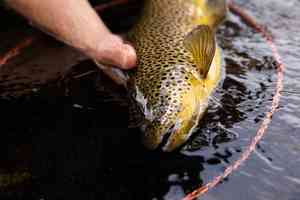

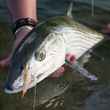




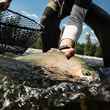

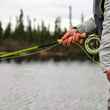

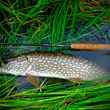

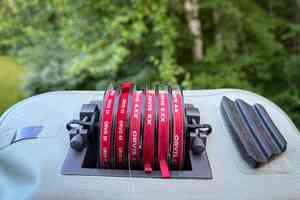
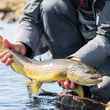
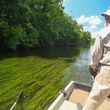
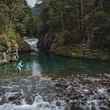




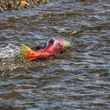

Comments
karin miller replied on Permalink
Oh yeah. People constantly unestimate the abilities of the tenkara method. I've landed plenty of bonefish, barracuda, jacks, junior permit and bluefin, char, huge browns, massive rainbow, monster carp, sockeye, chum, silvers and king salmon...plenty of grayling to boot. ..even small tarpon and sharks. In April I'll target golden dorado on tenkara. Its a whoot and often takes more skill than will the benefit of a reel. Congrats to you.
Pages